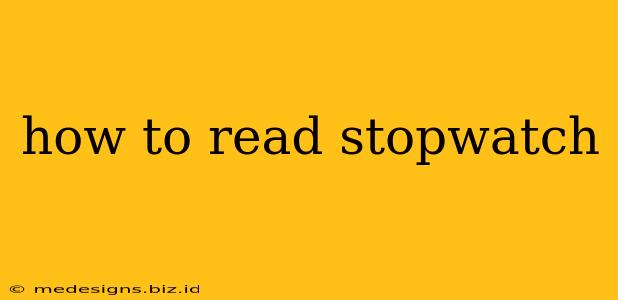Stopwatches, those trusty time-measuring devices, might seem straightforward, but understanding how to read them accurately is crucial for various activities, from sports timing to scientific experiments. This guide will walk you through the process, covering both analog and digital stopwatches.
Understanding Analog Stopwatches
Analog stopwatches, with their spinning hands and multiple dials, might appear intimidating at first. However, with a little practice, reading them becomes second nature.
The Basics of Analog Stopwatch Dials
Most analog stopwatches feature several dials:
- Seconds Dial: This is usually the largest dial and shows seconds, typically completing a full rotation in 60 seconds.
- Minutes Dial: This smaller dial shows minutes, moving one increment for every 60 seconds on the seconds dial.
- Hours Dial (Sometimes): Some stopwatches even include an hour dial, useful for longer time intervals.
How to Read an Analog Stopwatch: Simply look at the position of the hands on each dial. The seconds hand's position indicates the seconds elapsed, the minute hand the minutes, and the hour hand (if present) the hours. For example, if the seconds hand points to the 20 and the minutes hand to the 3, the elapsed time is 3 minutes and 20 seconds.
Interpreting Multiple Hands
Reading an analog stopwatch effectively involves recognizing the relationship between the hands. It's crucial to see how the seconds hand affects the minute hand. Each full rotation of the seconds hand advances the minute hand one increment. Similarly, a full rotation of the minute hand advances the hour hand (if it exists).
Mastering Digital Stopwatches
Digital stopwatches are generally much easier to read than their analog counterparts. They display the elapsed time directly as numbers.
Understanding the Display
A typical digital stopwatch display shows the elapsed time in hours, minutes, seconds, and sometimes even fractions of a second (tenths or hundredths). The numbers are clearly arranged, making it easy to see the precise time.
Common Features of Digital Stopwatches
Most digital stopwatches offer features like:
- Start/Stop Buttons: To initiate and halt the timing process.
- Reset Button: To clear the display and return to zero.
- Lap/Split Function: To record intermediate times without stopping the main timer. This helps in tracking individual segments within a longer duration.
Tips for Accurate Stopwatch Reading
Regardless of whether you're using an analog or digital stopwatch, remember these tips:
- Start and Stop Precisely: Ensure you begin and end timing at the exact moment required.
- Practice Makes Perfect: The more you use a stopwatch, the faster and more accurately you'll be able to read it.
- Familiarize Yourself with the Layout: Understand the specific dials or displays on your particular stopwatch.
- Check for Accuracy: Occasionally test your stopwatch against a known accurate time source.
Stopwatches in Everyday Life
Stopwatches find applications in diverse fields:
- Sports: Tracking race times, exercise intervals, and personal bests.
- Science: Measuring reaction times, experimental durations, and other precise measurements.
- Cooking: Timing cooking processes for optimal results.
- Gaming: Tracking game scores or individual performance metrics.
By understanding how to accurately read and utilize a stopwatch, you'll enhance your precision and efficiency in numerous activities. Whether it's an analog or digital model, the basic principles are the same: focusing on the hands and digits and understanding their relationship to one another.
